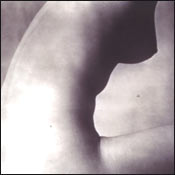
Today, people constantly argue about the right way to present the naked body. Is a body too fat, too thin, too real, too ideal, too commercial, too sexist? They should argue about something else. There’s no right way to present the body. The language of the nude is volatile and always changing; it expresses the full range of human feeling – rage, love, disgust, control, abandon, longing. It can yield the most delicate dream and the harshest reality.
In fashion photography, the female body is usually presented as an idealized form. That ideal can be striking or glamorous or playful, but it is rarely profound; the body remains a hanger for clothes. In the late forties, Irving Penn, one of the great fashion photographers of the twentieth century – not to mention an important artist – grew impatient with the limited approach of fashion magazines. On his own time, he began photographing the female nude. He chose to depict ordinary, fleshy bodies – real bodies, that is, ones that had some fat and sag. About 50 years later, he once again turned to the nude. And again he chose a fleshy model, the dancer Alexandra Beller from the Bill T. Jones/Arnie Zane Dance Company.
These two series are now on display in New York, “Earthly Bodies” at the Metropolitan Museum of Art and “Dancer” at the Whitney Museum of American Art. They make a brilliant pair. In the series of nudes from 1949-50 at the Met, Penn focuses on the trunk of the body; we see no heads or feet. The absence of the model’s face not only increases the emphasis on her physical form but also abstracts her body to some extent. The organizer of the show, Maria Morris Hambourg, appropriately likens these nudes to “fragmented antique torsos resplendent in the light.” But they also transform the female body into a kind of fertile landscape. In the form of the body you can almost see rolling hills, plains, rivers, forests, sunlight, and shade. The images are both distant – like a landscape – and intimate. (Penn shot very close to the model’s body.) The strongest and most mysterious occupy a region somewhere between the Earth and a woman’s body, and recall ancient fertility goddesses such as the Neolithic Willendorf Venus. They become the land where we were born.

Although both shows feature subjects who are more womanly than fashionably thin, the nude in “Dancer” could hardly be more different from her predecessors. If the Met’s nudes evoke antique torsos, the Whitney’s resemble – in the words of the show’s organizer, Sylvia Wolf – an “erupted sculptural frieze.” There is no feeling of stillness or repose in “Dancer.” On the contrary, the nude seems to move, to “erupt.” She reaches, stretches, twists, and bends. Her flesh appears heavy, but also muscled and strong. The shadows are dramatic. In a way, she looks like she is straining to break out of her earthbound body. In the final photographs, Penn lets Beller’s moving body blur the image. This does far more than simply emphasize quickness. As the body moves, it seems to create a kind of ghostly angel – a figure made of air and light who escapes from the weight of the flesh.
In both “Earthly Bodies” and “Dancer,” Penn elevates the body, but not cheaply or easily, as fashion does. He begins with the real human clay and renders it with unflinching directness. But then these very real bodies slowly grow in the imagination, until they are transfigured.
Irving Penn: Nudes
“Earthly Bodies,” at the Metropolitan Museum of Art, and “Dancer,” at the Whitney Museum of American Art.